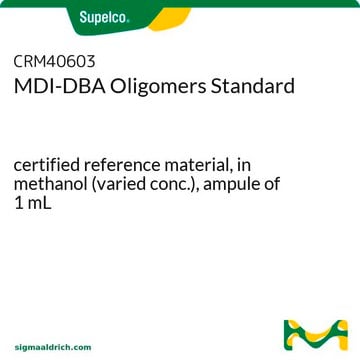33490
HMDI
analytical standard
동의어(들):
4,4′-Methylene-bis(cyclohexyl isocyanate), 4,4′-Diisocyanato-methylenedicyclohexane, 4,4′-HMDI, Bis(4-isocyanatocyclohexyl)methane
About This Item
추천 제품
Grade
analytical standard
Quality Level
품질
mixture of isomers
유통기한
limited shelf life, expiry date on the label
기술
HPLC: suitable
gas chromatography (GC): suitable
응용 분야
environmental
형식
neat
SMILES string
O=C=NC1CCC(CC1)CC2CCC(CC2)N=C=O
InChI
1S/C15H22N2O2/c18-10-16-14-5-1-12(2-6-14)9-13-3-7-15(8-4-13)17-11-19/h12-15H,1-9H2
InChI key
KORSJDCBLAPZEQ-UHFFFAOYSA-N
유사한 제품을 찾으십니까? 방문 제품 비교 안내
일반 설명
애플리케이션
신호어
Danger
유해 및 위험 성명서
Hazard Classifications
Acute Tox. 2 Inhalation - Eye Irrit. 2 - Resp. Sens. 1 - Skin Irrit. 2 - Skin Sens. 1 - STOT SE 3
표적 기관
Respiratory system
Storage Class Code
6.1A - Combustible acute toxic Cat. 1 and 2 / very toxic hazardous materials
WGK
WGK 1
Flash Point (°F)
235.4 °F - closed cup
Flash Point (°C)
113 °C - closed cup
개인 보호 장비
Eyeshields, Faceshields, Gloves, type ABEK (EN14387) respirator filter
Choose from one of the most recent versions:
이미 열람한 고객
자사의 과학자팀은 생명 과학, 재료 과학, 화학 합성, 크로마토그래피, 분석 및 기타 많은 영역을 포함한 모든 과학 분야에 경험이 있습니다..
고객지원팀으로 연락바랍니다.










